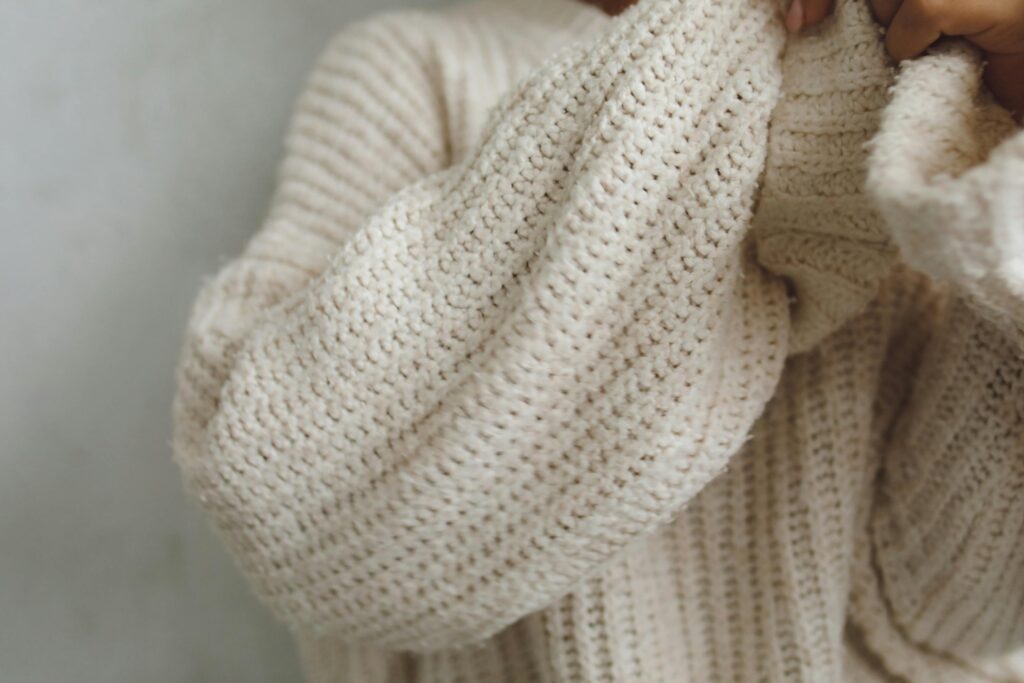Fast fashion has made clothing cheaper than ever, but at hidden cost to our health and our planet.
Most modern garments are made from synthetic fabrics like polyester, nylon, and acrylic. These materials are derived from fossil fuels, not natural sources. They often contain harmful dyes, plastic finishes, and chemical coatings that stay in contact with your skin all day. Every wash sheds microplastics that end up in our oceans, our bodies, and even our blood. Research now links synthetic fabric chemicals to hormone disruption, inflammation, and even DNA damage.
But it wasn’t always like this. For centuries, all fabrics were made from natural sources: plants, animals and minerals. These materials are biodegradable, breathable, and often carry a subtle energetic quality. In fact many people believe natural fibres vibrate more harmoniously with the body, enhancing overall wellbeing.
So what can we do about it? If you’re looking to build a cleaner, healthier and more conscious wardrobe, starting with natural fabrics is the first step. Here are the five best ones to know…

1. Linen
Linen is made from flax, one of the oldest and most sustainable fibers on the planet. It’s light, breathable, and looks better the more you wear it. It has been used for clothing, bedding, and household items for thousands of years. Linen fibres are strong, breathable and naturally antibacterial, making this fabric ideal for warm-weather clothing.
You’ll often find linen in summer dresses, shirts, pants, and sleepwear. A billowy linen shirt in summer? Chef’s kiss. It absorbs moisture without feeling damp, which makes it a favourite in hot and humid climates. Over time, linen softens and develops a worn-in, relaxed texture that many people love.
That said, linen wrinkles easily, which is part of its natural character but not everyone’s preference. It also tends to be more expensive than cotton, and may require a little more care when washing or ironing.

2. Cotton
Cotton is a soft, fluffy fiber that comes from the cotton planet. It is one of the most commonly used natural fabrics in the world, known for its breathability, versatility, and comfort. Organic cotton is grown without synthetic pesticides or fertilisers, making it much healthier and a more eco-friendly option.
Cotton is ideal for t-shirts, underwear, jeans, sheets and just about every basic clothing item. It absorbs moisture well and allows the skin to breathe, which is especially important for people with skin sensitivities or allergies.
However, not all cotton is created equal. Conventional cotton farming uses a significant amount of water and chemicals, which can harm both the environment and the workers involved. Look for organic, fairtrade, non-GMO, unbleached cotton wherever possible.

3. Leather
Leather is made from the tanned hides of animals, usually cows, goats, or sheep. While it’s not a fabric in the traditional sense, it has been used for centuries for durable outwear, footwear, bags and accessories. High-quality leather is breathable, naturally water-resistant, and moulds to your body over time.
A well-made leather jacket, belt or pair of boots can last decades, aging beautifully and developing a unique patina. Unlike plastic-based faux leather, which crack and sheds plastic toxins as it degrades, real leather can be a sustainable option when sourced responsibly.

4. Silk
Silk is spun by silkworms, which spin fine threads to form their cocoons. . These threads are harvested and woven into a smooth, glossy fabric with a luxurious feel. Silk is incredibly lightweight and has natural temperature-regulating properties. It keeps you warm in winter and cool in summer.
Silk is commonly used for blouses, dresses, scarves, lingerie, and sleepwear, as well as pillowcases and eye masks. It’s gentle on sensitive skin as it’s hypoallergenic. The molecular structure of silk is actually close to human skin, which is why it feels so damn good.
However, silk is delicate and can stain easily. It often needs to be hand-washed or dry-cleaned and it may not hold up well with frequent wear.

5. Wool (or Cashmere)
Wool is basically nature’s performance fabric. It keeps you warm and breathes. It’s naturally odour-resistant, moisture-wicking, and even flame-resistant. Wool comes from the fleece of a sheep, which is sheared once or twice a year and spun into yarn.
Cashmere is a softer, more luxurious version , kind of like wool’s refined cousin. It is sourced from cashmere goats, primarily in Mongolia and China. These fibers have natural insulating properties, meaning they keep you warm by trapping heat whilst still allowing moisture to escape.
Wool is excellent for sweaters, coats, scarves, socks and thermal underlayers. Because of its natural lanolin content, it resists odours and stains, and often doesn’t need to be washed as frequently as synthetic fabrics.
However, wool can sometimes feel itchy against the skin, especially if not high-quality or blended with softer fibres. Cashmere is softer, but also more expensive and delicate. Some types of wool require careful washing or dry cleaning to maintain their shape and texture.
What about Synthetic Fabrics?
Sometimes synthetics have their place. They’re cheap, they stretch, they dry fast, and they can be useful for things like activewear or rain jackets. But they’re not something to live in every day. They’re not skin-friendly and fast-fashion is one of the biggest contributors to our planet’s waste.
The good news? Natural textile innovation is on the rise. We’re seeing hemp blends, bamboo viscose and plant-based performance fabrics making waves. Hopefully one day we won’t need synthetics at all.

